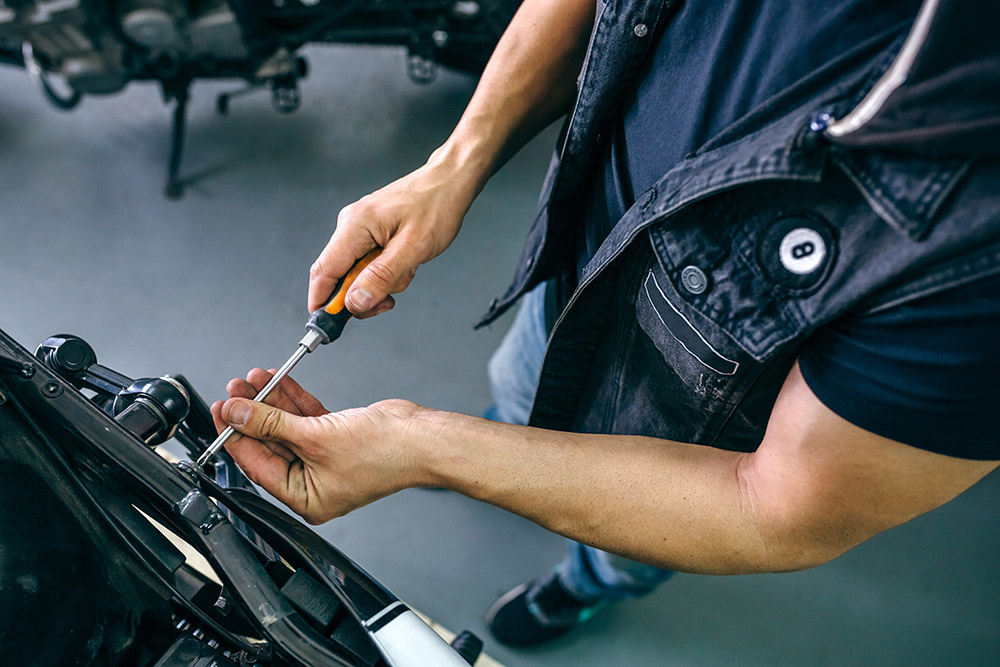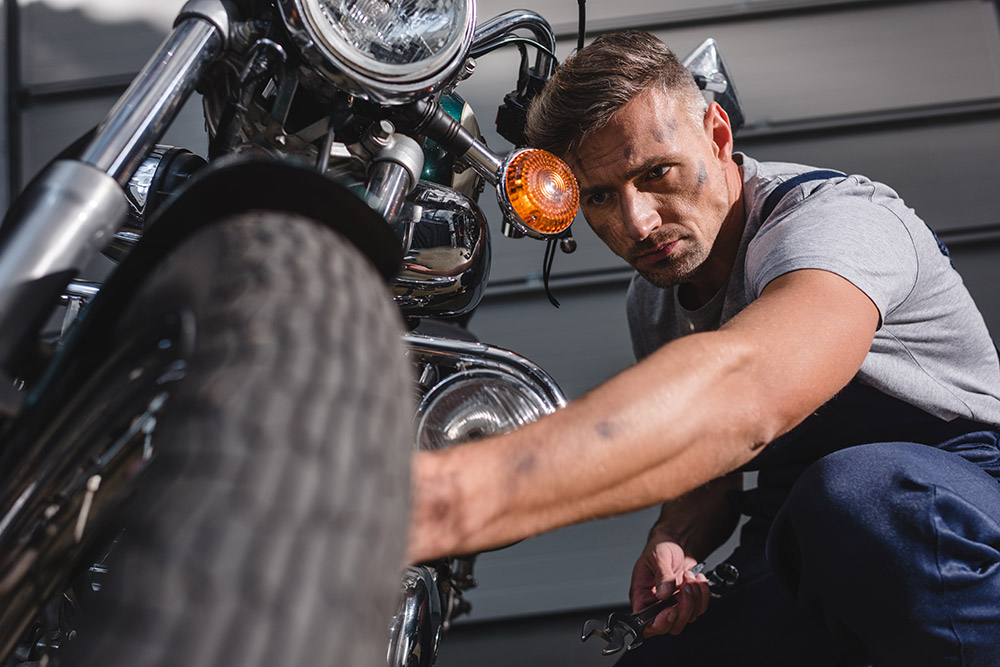
Look, it seems like every year, we field questions about “best practices” for winterizing your bike, and it can’t be said enough. Yeah, you could go back and dig out my old posts about it, but since winter came a little later for a lot of North America, let’s revisit some basic winterizing procedures.
Yeah, they’re generic, because I don’t know if you’re storing your scoot in a heated shop, a covered back porch, or if your bike is air cooled, fuel injected, or whatever. As the snow flies, though, and as motorcycle enthusiasts, we’re not spending a lot of time on our bikes. So let’s go over some basics to make sure your bike is easy to get back on the road in the Spring.
- Start with a Clean Slate
Before tucking your motorcycle away, give it a thorough clean. We talked about this a few posts ago, so there’s really no need to dig too deep. Get that sucker clean, do the deferred maintenance, and start with a clean bike before you winterize it.
Dirt, road salts, and grime are your bike’s enemies, potentially causing corrosion and rust. Wash every inch of your motorcycle, dry it meticulously, and spend some time detailing it. It WILL pay off.
- Fresh Oil for a Fresh Start
Old oil is like an unwelcome guest; it can do more harm than good. Used oil contains contaminants that could damage your engine over time. So, change the oil and filter before storage. This simple step can significantly extend your engine’s life, ensuring that when spring arrives, your bike is as ready as you are.
A lot of riders who don’t necessarily put on a lot of miles think that the number of miles on an oil change is the only consideration. It’s not. As oil ages, especially when not being warmed and circulated properly, it can take on some nasty traits, turning acidic, mixing with water via condensation, and so on. So even if you “only” rode 2,000 miles last year, you still need to change the oil. It’s incredibly cheap insurance.
- Full Tank, Fewer Worries
An empty gas tank can become a rusty one. Fill up your tank and add a fuel stabilizer to prevent rust and keep the fuel fresh. Run your engine for a few minutes to allow the stabilized fuel to circulate.
The reasoning is simple: condensation from temperature changes in the tank can introduce water into the tank, rusting it out while negatively impacting your fuel system’s health. Trust me, water in your fuel – and thus, your carb or injectors – is a crummy deal that is going to cost you drivability and – more importantly – a fat bill from the stealership cleaning everything up. More than one of us has bent a pushrod because impurities in the fuel caused a valve to stick at the wrong place. It’s a small step with big benefits for your bike’s fuel system.
- Seal the Entrances
Your motorcycle’s exhaust and intake are gateways that need guarding. Moisture and pests can enter through these passages, causing damage you might not notice until it’s too late. Use exhaust plugs or cover these openings, and make these protectors conspicuous so they’re not forgotten when it’s time to ride again. This is especially true if you store your bike in a barn or unheated outbuilding where rodents hang out. About ten years ago, a buddy of mine and I fired up an ancient GoldWing and blew a mouse nest (with what had just been live mice) onto the wall behind us.
- Battery Care Is Self-Care
The heart of your motorcycle, the battery, demands attention. Disconnect it and store it in a cool, dry place. A battery tender or trickle charger is ideal for keeping it healthy through the winter months, ensuring it has the power to spring back to life when needed. I’ve found the newer trickle chargers to be a solid, but inexpensive investment. They won’t overcharge a battery, but they’ll certainly keep it topped up without boiling it over.

- Lubricate to Last
Lubrication is like a protective embrace for your bike’s moving parts. Apply a quality lubricant to the chain, control cables, and pivot points. This step is about preventing rust and ensuring smooth operation when it’s time to hit the road again, but you’d be amazed at how few riders ever think about cable controls until something gets sticky or freezes up completely. A little lubrication on the situation works wonders.
- Tire Care: Elevate and Rotate
Flat spots are a tire’s nightmare. If possible, store your motorcycle on a stand to take the weight off the tires. If a stand isn’t available, rotate the tires periodically throughout the winter. It’s a bit of effort that can save you from flat spots, leading to uneven wear, vibration, and crappy tire life.

- Under Cover, Out of Harm
Even in the sanctuary of a garage, a motorcycle cover is essential. It protects your bike from dust, moisture, and the unexpected. Choose a breathable cover to prevent condensation, because rust – like Niel Young say, never sleeps.
One other thing to consider? When you do cover up the bike, I also like to try to limit the “tenting” effect a cover can have. One of my old cats, who has long since passed away, used to like to sleep under the cover of my bike, which wasn’t a problem, but I’d have to go searching for the bastard on cold nights, and spend twenty minutes looking for him before he’d show up. That Spring? I pulled the cover off the bike and found where he’d been napping on the coldest of days.
- Coolant Check: Freeze Prevention
For liquid-cooled motorcycles, antifreeze is a winter must. Ensure the coolant mixture is appropriate for your storage conditions. This simple check can prevent freezing and engine damage, a crucial step for those storing their bike in colder, unheated spaces. In reality, if you know, you know, so this might seem to be common sense, but I’ve run into more than a few riders who actually didn’t understand their new bike was liquid cooled. Might have made for an unpleasant Spring fire up!
- Resisting the Temptation to Start
Many believe that starting the motorcycle periodically during winter is beneficial. However, unless you’re able to bring it up to full operating temperature, starting it can do more harm than good, leading to condensation inside the engine. The truth of the matter is it doesn’t really take that long to warm up an air cooled engine, but just letting it warm up and idle really doesn’t do it a lot of good. The value of starting it and letting it come up to temp is really to not only distribute oil, decrease potential deposits, and also, to burn condensation out of the crankcase. Guess what? That really doesn’t happen when you let it idle for thirty minutes. It’s got to have some time at higher RPMs, as though you’re riding it, to really pay off. Best to just let it sleep.
- The Perfect Spot
Finally, where you store your motorcycle is as important as how you store it. Choose a secure, dry spot away from direct sunlight and harmful chemicals. This isn’t just about storage; it’s about creating a safe haven for your bike.
Winter storage is a ritual that speaks of care, foresight, and anticipation for the next riding season. By following these best practices, you’re not just storing a motorcycle; you’re preserving a passion. When the roads call again, you and your bike will be ready to answer with gusto.
Store the shiny side up!







Thank’s for sharing great insights!
It is Great Information, I planning Long trip in winter and this blog is very useful for me.
Interesting story and it is most important for who is drove
Great information, this blog is very useful.